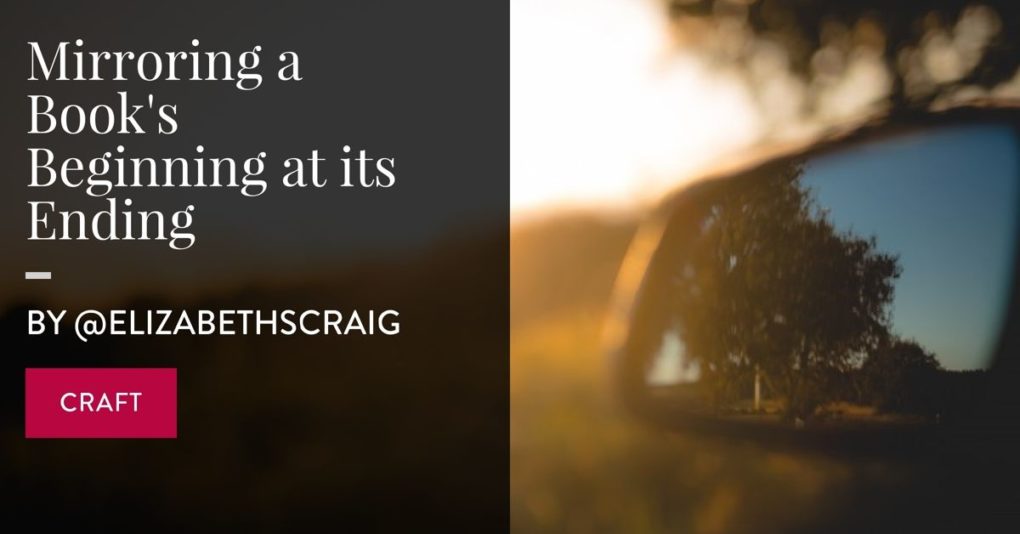by Elizabeth S. Craig, @elizabethscraig
Many writers have a hard time with beginning and ending their books. I’ve never had much trouble starting a book (I rarely vary from starting with dialogue between two important characters), but endings I really used to struggle with.
If you’re like me, there’s a technique you could try to see if it makes your book’s ending stronger. It’s a reflective, or mirroring technique. The idea is to subtly remind the reader at the book’s close of a similar scene at the beginning of the book. It helps lend a full-circle feel to a story and can offer a satisfying ending for readers and a sense of closure.
I saw an interesting tweet recently from Open Culture. They featured a supercut by Jacob T. Swinney of the first and final frames of 55 different films, shown side by side. Many of the films had reflective endings–and the ones that resonates the most with me did.
For my books, I use it mainly to re-establish order at the end of the book. The idea behind these gentle mysteries is to have an idyll at the beginning of the book. Someone destroys the idyll via murders but, by the end, justice is served and peace is restored again. It’s very tidy. The loose ends are tied up. My characters may be in the kitchen eating tomato sandwiches at the beginnings and ends of the story. This technique can signify that, although the protagonist has overcome all sorts of trouble and conflict, some things remain, comfortingly, the same.
But you can get fancy with this technique, and expand it into other areas of your story. Fantasy writer Janice Hardy has some great ideas in this post on working other mirroring techniques into your story. As she explains the role of these types of mirrors:
Mirrors aren’t just copies, but ideas and themes reflected in characters and situations around the protagonist. Sometimes they match the protagonist’s emotions or choices, other times they reflect the opposite, but they deepen the story by allowing the protagonist (and reader) to “experience” other potential outcomes without derailing the story. Stakes become more real when we see them occur, and the right mirror can do a world of foreshadowing and raise the tension.
Do you use mirroring techniques in your stories? For endings, or in other ways? As a reader, is this something you notice or find satisfying?
Using mirroring techniques in a story: Click To TweetPhoto via Visualhunt

Hi Elizabeth – what a great way of describing a beginning and an ending … to me it seems like about the only thing I remember in English at school … dreadful English that is! … but to get to my point … start, middle and summarise – once or twice I’ve had to do a sudden take in my posts! Someone wondered where my post was taking them and then thankfully I’d added in the summary bit … but it was noted!
Your stories are gentle and now I’ll keep an eye open for the mirroring technique … cheers Hilary
I have days like that, too! It gets easy to meander in the middle of dialogue sometimes. :) Yes, I think it can be very satisfying for readers when there’s a nice, mirroring, ending.
The mirroring technique is a great way to bring the story to a close. As a reader, it’s nice when the ending kind of wraps everything up and gives you that feeling that all is right with the world again even if there is a hint of something else to come.
I think so, too. It’s nice to get a feeling of resolution at the end of a story.
I think I’ve done it twice and neither was on purpose. Something to consider if I write another book.
Sounds like you’re using the technique naturally!
This does sound like a good strategy, Elizabeth. It does give that ‘full circle’ sense of closure to the book. And, I think, it can give readers a look at how the events of the book have changed the characters. Thanks – this is helpful.
I think so, too, especially if the ending is in the same setting as the beginning, but the characters are vastly different.
I like to call it coming full circle. I love how this mirroring technique brings closure in a good way.
I do, too. Thanks for coming by, Karen!
I’ve noticed the technique but never used it in my stories.
I used to dread endings, but this technique makes them much easier.
Great writing tip. Thank you for sharing.
Thanks for stopping by. :)
I like tying up lose ends and the full circle reminds me of life in general. Great post as always. I learn so much from your posts!
Thanks! Good luck with your writing!
Definitely a necessity. I LOVE when I see this concept executed correctly. It leaves any reader feeling like they’ve made a full journey. I especially love when authors take us back for a brief moment to where the character started vs where they’re ending. That’s when you see the true power of the story.
It’s a very effective technique, I think. I love that kind of a full circle feeling. :)